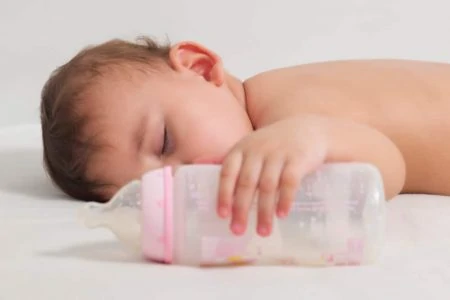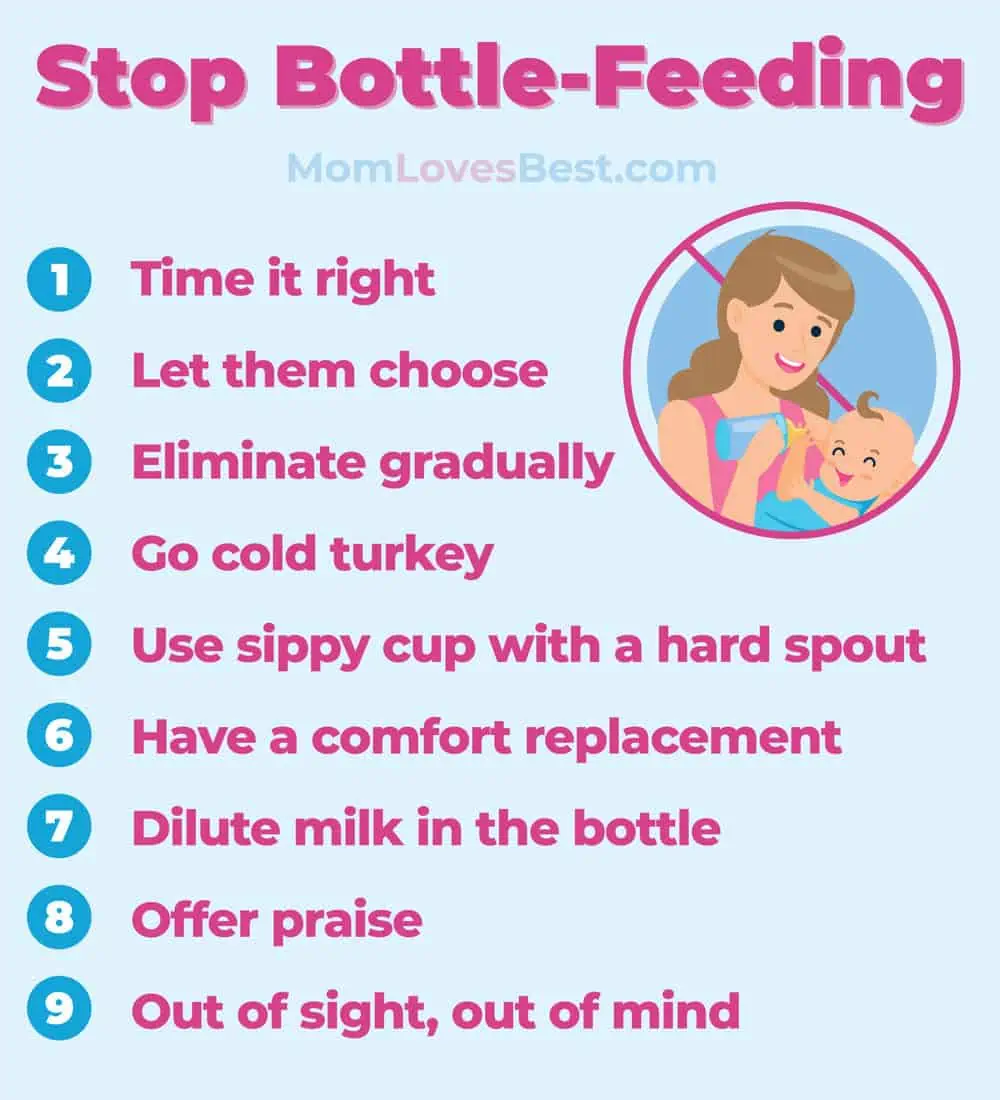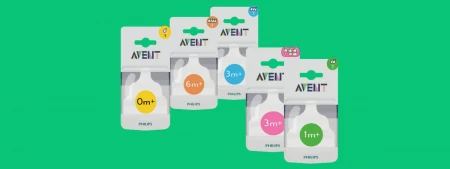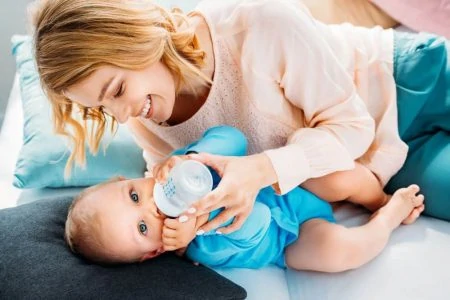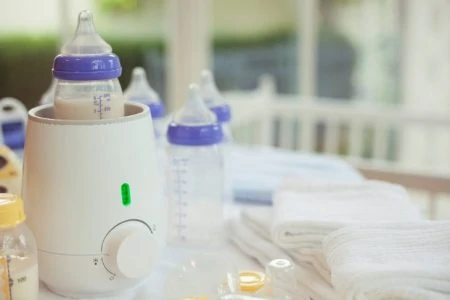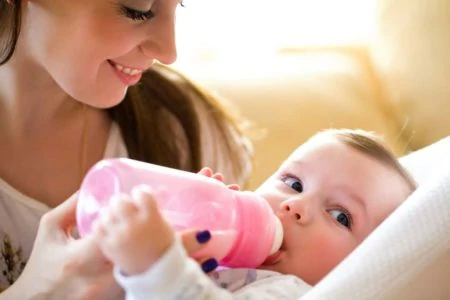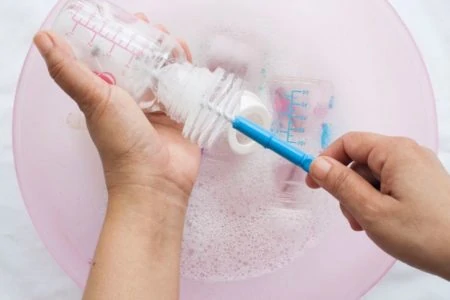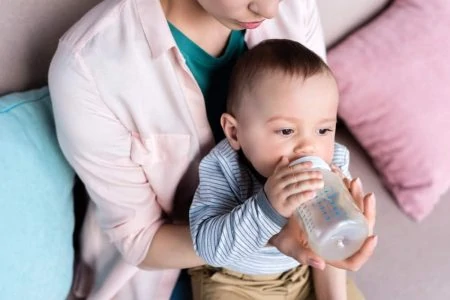Is it time to break up with the bottle? It’s a huge milestone, and if you’re feeling a mix of pride and dread, you aren’t alone. Babies love their bottles; they provide nourishment, comfort, and routine.
However, prolonged bottle-feeding can lead to dental issues and picky eating, making the weaning process harder the longer you wait. But how do you know when your baby is truly ready to start transitioning from the bottle? And what is the secret to doing it without a total meltdown?
We’ve been there. In this guide, we’ll break down exactly why it’s time to switch, the ideal timeline for weaning, and practical tricks to help you ditch the bottle for good.
Key Takeaways
- Know the risks: Prolonged bottle-feeding is linked to tooth decay, ear infections, obesity, and potential speech delays.
- Follow the timeline: The American Academy of Pediatrics suggests introducing cups around 6 months and completely phasing out bottles between 12 and 24 months.
- Start slowly: Begin by swapping one daily bottle feeding for a sippy or straw cup, gradually working your way toward the bedtime bottle.
- Stay consistent: Whether you choose the cold turkey method or a gradual fade, offer plenty of praise and stick to your new routine.
Reasons to Stop Bottle-Feeding
A bottle seems harmless enough. It delivers milk and keeps your little one happy, so what is the rush? Unfortunately, hanging onto the bottle for too long can impact your child’s health and development.
Here is why experts recommend weaning sooner rather than later:
- Risk of tooth decay: When a child nurses on a bottle nipple throughout the day, their teeth have prolonged contact with natural sugars in milk or juice. This is the leading cause of cavities in toddlers (1). The “bedtime bottle” is the biggest culprit; if milk pools in the mouth while they sleep, it can eat away at the enamel.
- Higher chance of ear infections: Drinking from a bottle while lying flat can cause milk to flow into the eustachian tubes. This fluid buildup creates a breeding ground for bacteria, leading to painful ear infections.
- Potential for obesity: Babies often drink more from a bottle than a sippy cup. Toddlers generally need about 16-24 ounces of milk daily, but it is easy to exceed that when using a bottle for comfort. Since milk is calorie-dense, using it to soothe a crying toddler can lead to rapid weight gain.
- Iron deficiency anemia: If a child fills up on cow’s milk, they are less likely to eat iron-rich solid foods. Additionally, calcium in milk can block iron absorption. This creates a cycle where the child isn’t getting the nutrients required for proper growth (2).
- Oral development issues: Extended bottle use can impact the development of mouth muscles and the palate. Studies suggest that bottle-fed babies may be more likely to develop crooked teeth or bite misalignments due to the sucking motion required by the artificial nipple.
When Should Bottle-Feeding Stop?
The longer you wait to boot the bottle, the harder it becomes. As toddlers grow, they become more independent, opinionated, and emotionally attached to their routine.
Take Note
The American Academy of Pediatrics (AAP) recommends weaning from the bottle by 12 months of age. Ideally, bottles should be completely phased out by 24 months (3).
You don’t have to wait until the first birthday to start. It is best to introduce a cup around six to nine months. Start by offering small amounts of expressed breast milk, formula, or water in an open cup or straw cup during mealtimes. This helps them learn the mechanics of drinking without a nipple.
By the time your little one reaches the one-year mark, they should be comfortable enough with a cup to start swapping out bottles. This is also the standard time parents switch from formula to cow’s milk, making it a natural transition point.
How to Stop Bottle-Feeding
Ditching the bottle can feel like a battle, but having a game plan helps reduce the stress for everyone.
Here are proven strategies to make the transition smoother:
- Timing is everything: Avoid starting this process during other major life changes. If you are moving, welcoming a new sibling, or starting daycare, wait until things settle down. Toddlers cling to routines when they feel insecure.
- Involve them in the process: Take your toddler to the store and let them pick out their own “big kid” cup. Giving them a sense of ownership can make them excited to use it rather than the bottle.
- The gradual fade: If you prefer a gentle approach, start by replacing one bottle feeding a day with a cup. Stick with that for a few days, then swap out a second bottle. Save the bedtime bottle for last, as that is usually the hardest one to give up.
- Cold turkey method: For some determined toddlers, prolonged weaning just causes more confusion. In this case, pack up all the bottles one morning and simply stop offering them. It might result in a rough day or two, but many children adapt surprisingly fast.
- Choose the right cup: Dentists often recommend moving to straw cups or open cups like the Babycup or BabyBjorn Cup rather than hard spouts. Straws and open rims promote better oral muscle development than spouts, which require a similar sucking motion to a bottle.
- Offer a comfort replacement: If the bottle is a security object, offer a new source of comfort. This could be a special blanket, a doll, or a stuffed animal. Offer extra cuddles and reassurance when they ask for the bottle so they know they are safe and loved.
- The watering down trick: If your child refuses to let go, try diluting the milk in their bottle with water. Gradually increase the water content over a week until the bottle contains only water. Meanwhile, put the yummy, full-fat milk in their new cup. They will likely start choosing the cup to get the good stuff.
- Celebrate the wins: Use positive reinforcement. Offer high-fives, a sticker chart, or verbal praise every time they use their cup. Avoid shaming them for asking for a bottle; just gently redirect them to the cup.
- Out of sight, out of mind: Once you decide to wean, hide the bottles. If your child sees them on the drying rack or counter, they will want them. Once the transition is complete, get them out of the house entirely or have your child help you “pack them away” for other babies.
FAQs
You Can Do This
Saying goodbye to the bottle is the end of an era, but it is also a celebration of your child growing up. Weaning helps prevent long-term health issues like tooth decay and iron deficiency, setting your little one up for a healthy future.
Remember to introduce cups early, around six months, and aim to be fully transitioned by the time they hit their first birthday or shortly after.
Be patient with yourself and your toddler. Whether you dilute the milk, go cold turkey, or let them pick out a cool new cup, consistency is key. You’ve got this, mama!
